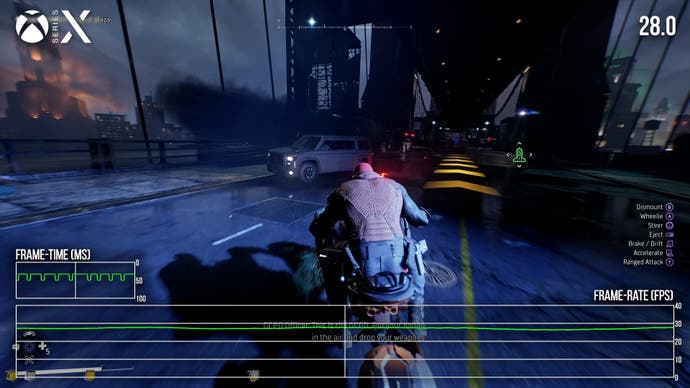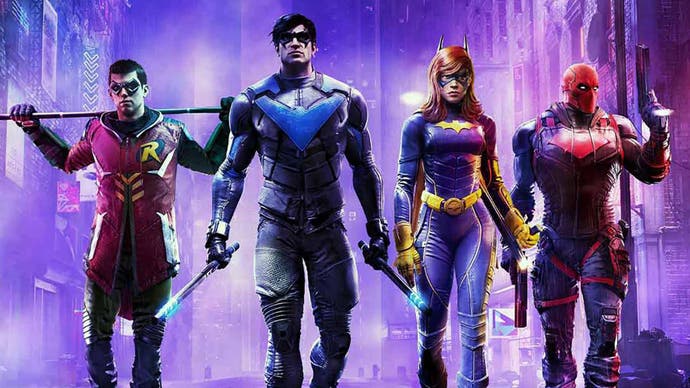Gotham Knights is a poor effort with a range of technical issues
And the 30fps cap is just the tip of the iceberg.
Gotham Knights has some big shoes to fill as a follow-up to the brilliant Batman Arkham Knight, an early last-gen title that pushed graphical and gameplay boundaries. Even today, the Rocksteady game impresses with a gritty, rain-soaked rendition of Gotham City swarming with criminals. Unfortunately, Gotham Knights fails to hit the same heights from a gameplay perspective, while there are big questions about its technical make-up. Why limit performance to 30 frames per second? Why were the last-gen versions cancelled with little technical ambition here? And after Arkham Knight, how come the game looks visually underwhelming?
The cancellation of the last-gen versions is puzzling because this is a thoroughly last-gen title in terms of its basic visual make-up - expect to see decent-looking PBR materials, a baked global illumination system, and extensive TAA coverage. Even relative to eighth-gen standards though, this isn't great stuff. Characters and other dynamic objects often stick out dramatically from the environment, for instance, lacking any sort of cohesion within the GI system. This is a common issue when dealing with baked GI of course, but the results here are often poor - with characters often looking like they have no integration into the game lighting at all, weirdly glowing. When lots of dynamic lights are onscreen there's a closer match between the lighting systems, as would be expected, but under primarily indirect lighting the results can look odd.
There are other issues with the lighting and shadowing. Ambient occlusion is quite restrained here, so geometry doesn't seem grounded very effectively within the environment. Specular highlights are another concern, which are often misaligned with the objects onscreen. This tends to stick out quite a bit as the gameworld is always dark and rain-slicked, in typical Batman fashion. These aren't huge issues taken individually but they make Gotham City feel disjointed. Overall the city feels quite clinical and much less stylised than you'd expect. Gotham has a certain visual signature in other media, a version of New York City with an emphasis on older architectural styles, often portrayed at night and with heavy rain.
Here Gotham doesn't distinguish itself from other open-world titles. The city layout itself is wide-open and modern, with broad avenues, a simple grid layout, and contemporary building styles. Objects in the far distance are often quite easy to see given the lack of smoke and other visual obstructions. Most baffling however is the lack of rain. If you look very closely you can spot rain in most outdoor scenarios, but it's barely visible, never rising to anything above a mild drizzle. The game's visual design just doesn't make much sense, especially considering how the city is depicted in other titles, especially Arkham Knight. This is a pretty serious and grimy game that takes place after Batman has been killed, so the clean and somewhat generic look just doesn't feel appropriate.
That said, there are aspects of the visuals that do work well. Oddly enough for an open-world title, interior spaces are a highlight. These areas are very detailed and feel like a closer match for the Batman aesthetic, with grimy corridors and moody volumetrics. The art and design can impress, like the neon-soaked archways of the Iceberg Lounge. It's definitely still mired firmly in cross-gen tech here, but the results are at least consistent with expectations for a big-budget release.
Asset quality is quite high in certain areas across the game, especially indoors. This evidence locker is packed with geometric detail and variety, for instance. On close inspection, most of the assets in closed-off zones hold up very well - clearly a lot of effort went into putting these areas together. Geometric and texture detail takes a bit of a hit in the open world as you might expect, although at typical viewing distances there are no issues. Plus, player and enemy models are generally high-quality.


My overall impression of Gotham Knights is that it's less than the sum of its parts. A lot of time and hard work has clearly been poured into this game, but strange design choices, odd technical hangups, and a lack of aesthetic commitment make the final product underwhelm. Evaluated on its own terms, Gotham Knights is a generic and unexciting game that has its moments, but that ultimately falls well behind the curve for an open-world title.
But many people aren't evaluating Gotham Knights on its own - they are comparing it to Arkham Knight, Rocksteady's last-gen classic and comparisons are not flattering. Arkham Knight's Gotham City is a mess of dense, centuries-old stonework and narrow roads, bathed in smoke and drenched with rain. Gotham Knights has a much more generic atmosphere, in contrast. Certain differences immediately stick out, like rain effects, which come down thick and interact nicely with lighting in the earlier title, and are virtually non-existent now. The atmospheric effects and fog have been carefully crafted to make for a convincing skyline, with certain elements like window lights, managing to pierce through. Gotham Knights' distant detail looks like a soupy mess in contrast.
By comparison, Gotham Knights just looks lifeless - and that's actually literally true as well. Arkham Knight was swarming with gangs of criminals and fleeing pedestrians. You couldn't go very far on foot without being confronted by gangs of enemies ransacking the city. Gotham Knights is so devoid of life by comparison that I could drive around for minutes without spotting anything other than the occasional civilian. It's a pretty remarkable change and feels very odd.

In terms of atmosphere and effects, Rocksteady's Gotham beats this new rendition hands down. However, Gotham Knights does score some wins if you measure assets side-by-side. Arkham's texture work still looks perfectly fine, but surfaces generally do showcase higher-res 2D art in Gotham Knights. Chalk this up to running with extra memory perhaps, or possibly the more limited asset variety in Gotham Knights is helping somewhat. Interiors in general showcase less granular detail in Arkham Knight as well, though these environments are one of the few highlights in the game. More modern TAA also trumps the post-process anti-aliasing of Arkham Knight too, giving a cleaner look.
Years on though, it seems clear to me that Arkham Knight is the more accomplished title. It showcases a much more coherent and attractive world, with beautiful environmental art and design. That applies to gameplay as well, sadly. Gotham Knights has a somewhat clunky combat system that I never really felt very connected to over my hours of play. It's functional and most of the basics of melee fighting are present and accounted for, but it doesn't flow very well. Animation is a relative low point here, as character movement often looks jilted and odd, while combat in the older title is more flowing and impactful than the new game's rendition.
Arkham Knights' key gameplay change relative to prior entries was the introduction of the Batmobile, a sleek but powerful vehicle for Batman to use in enemy pursuits. Gotham Knights similarly features the Batcycle, a slimmer and two-wheeled variant that has similar features. However, this is a much less compelling gameplay device. The Batmobile navigated Gotham in a haphazard sort of way. Arkham Knight's city was snaked with winding roads and narrow alleys, so getting the Batmobile into position often required fast turns and seat-of-your pants driving. The vehicle suspension came alive and anything you hit - cars, fences, even stone barriers and columns - would break apart in a shower of sparks and rubble.
Gotham Knights' Batcycle is boring by comparison. The broader, more conventional city layout in this game means that this new bike is much less exciting to drive. Most of the time you'll be going down straight roads with minimal obstruction. Turning feels odd, as the camera feels almost glued to the back of the bike - the game doesn't let you really feel the back slide out with a less responsive camera like in Arkham Knight. The sense of speed in Gotham Knight is lessened dramatically from Arkham as a result of these changes, alongside reduced motion blur compared to the earlier title. The corners of the screen do get a 'speed arrows' 2D effect overlaid to enhance the feeling of velocity but I found it distracting and I wish there was a toggle to turn it off.
In most respects, Gotham Knights falls well short of its predecessor. It's a serviceable action title with unsatisfying visuals, without the gameplay or visual flair that made Arkham Knight so unique. There are technical problems too, though to discuss positives first, image quality holds up. PS5 and Series X both manage a 4K presentation, rendering a 2160p pixel count at maximum, while Series S turns in at 1440p. Dynamic resolution is a possibility, though I didn't encounter it in my testing. Overall image quality is very good on all machines, I have zero complaints here really - all versions of the game look stable and clean, with an excellent handling of distant detail. Even Series S looks good and appears surprisingly comparable to the premium machines in still shots. The primary difference is a little bit of visible edge aliasing on Series S at times, a minimal amount of additional image breakup, and somewhat less detail, though this is hard to notice from typical viewing distances.
Outside of resolution, the predominant visual difference is the addition of ray-traced reflections on Series X and PS5. These are high-quality and apply to most reflective surfaces, adding an extra layer of depth. Even the ocean surface gets RT reflections here, though it looks somewhat noisy as you might expect. Examined up close, reflections generally resolve with a good level of detail and seem to reflect a reasonably complex version of the environment. I did notice that certain screen-space details were overlaid on reflective surfaces when available, enhancing the final resolve of the reflection. Series S, as expected, falls back to the last-gen staples - cube-maps plus screen-space reflections. The results look reasonably high-quality, though stability takes a backseat to the RT implementation, and reflective surfaces that run parallel to the camera look quite off at times.


In terms of performance, true to the developer's word, we're getting just one visual mode here: there are no graphical settings tweaks available outside of colour correction. That should mean 30fps gameplay, at least on paper. Gotham Knights targets 30fps, but it is constantly beset by frame-rate drops, stutters, and frame-rate time fluctuations, especially evident in traversal. Interiors fare somewhat better, with fewer of the large performance drops, though the odd frame-time issues persist. Perhaps these areas stress the game's core rendering systems less, or trigger fewer issues with streaming. In any case, this is as good as it gets, though it's still unacceptably unstable - and this applies to all console platforms.
Perhaps the worst frame-rates I encountered were in the train terminals. I was able to get performance to collapse here, with lows around 20fps. There's no clear reason for this, although I was able to tank frame-rates across multiple runs through multiple terminals on the Xbox Series X. I didn't have any luck, however, in replicating this behaviour on the Series S or PS5, so perhaps this one issue is Series X-specific, or only emerges after a specific trigger. Really though, performance in this game is unacceptable. It seems like we are getting a mix of smaller frame-time problems, which should be fixable, along with problems with stuttering and frame-rate dips, which may prove more fundamentally challenging. At the moment, Gotham Knights can't even deliver a stable 30fps, falling well short of expectations.
If you want to play a Batman game, go back to the seventh and eighth-gen Batman titles in the Arkham series. Every one of those games - especially the excellent Arkham Knight, and including Arkham Origins, which was developed by WB Games Montreal as well - is a solid experience. Gotham Knights, in contrast, is beset by bland visual design, dull gameplay, and unacceptably poor performance. There are some bright spots in the mix, but my overall impression is that this game needs a very substantial reworking before it is worth your time. Given the amount of time and effort that has been sunk into making this game, perhaps that could still happen. But for now, I'd recommend staying away.










